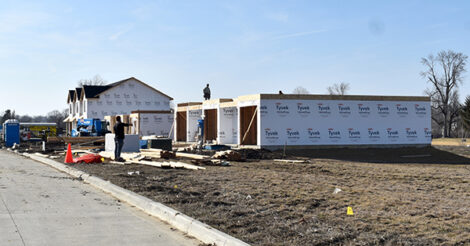From the air, landscapes reveal secrets

AERIAL PHOTOS BY GARRY BRANDENBURG Today's images were made a bit more than one week ago by this author while flying over beautiful landscape scenes in Marshall County. The weather that day was too good to pass up, so I made the most of the flight by recording scenes as one may envision them if you were a Bald Eagle. Altitude helps tremendously to see the entire scene. Ground based observations are just different. Aerial images allow people to see how things on the ground are interposed with fields, forests, grasslands and human projects. Today's images show Green Castle Lake and its park amenities for camping sites. Sand Lake is shown in relationship to the nearby Iowa River and lastly, the Iowa River and adjacent forest lands from the vicinity of Indian Bridge looking southeastward.
Today I will take you along for a short journey over Marshall County to observe landscapes from the Bald Eagle’s point of view. Flying offers the unique perspective of seeing the land in its entirety as its rolling hills reveal mixes of farmland fields, roadway systems and forests/grasslands/wetlands.
From just a few thousand feet of altitude, on a clear day, my camera was ready to record scenes of interest to me. Hopefully you can also enjoy these unique views.
The Green Castle Recreation Area will be the first area to receive our observation. This 116 acre site has been a public area since Jan. 1, 1977. Its 16 acre lake was already in place. Surrounding lands were partially farmed and part in pasture. It had potential for “remodeling/renovation” to create a public recreation site based upon the lake and its fish.
And so the process began over the next several decades to transform the area, according to a long range plan. Bit by bit, as finances allowed, things fell into place.
Initial first phases included construction of silt retention dams in which the tops of those structures also served as access and park roadways. Later, several shelter houses were constructed for shade and picnic spots. Drinking water was provided at two of the three shelters. Fishing opportunities were enhanced. New trees were planted, and one large field was seeded to prairie grasses.
An eight acre pasture was fenced to host a small herd of bison, an iconic and charismatic species of once native animals. An observatory site was offered to a local astronomy club for their interest in star watching and informative programs.
With those things in place, one would think that all was accomplished. The public used the site very well. One user of Green Castle, the late Ted Trowbridge, an avid fisherman, cast his line into Green Castle’s water on May 1, 1981.
The fish that took his lure was a White Crappie. This was no ordinary crappie. It was exceptional!
This big fish was weighed and measured for the record books. It was 21.25 inches long and hit the scale at four pounds, nine ounces.
This record still stands. The mounted fish is on display at the Grimes Farm and Nature Center for all to marvel at.
As the decades passed, additional improvements and developments transpired. Lake waters were lowered substantially in the early 2000s so that lakeshore renovations and silt removal could be undertaken.
Numerous fish habitat structures were built and placed along the shorelines. New jetties were built.
Rock called rip-rap, a wave energy dispersal stone, was placed along many portions of the shoreline. An island was built and a walkway bridge access was installed. A volleyball court was constructed, and a water access ramp for canoes/kayaks was built.
The next phases of long range planning involved building a modern campground with pads for recreational vehicles. An aerial image allows one to see the lakeside campsites and the newly built phase two camp area on the hill top west of the lake.
A modern shower house and toilet building adds to the amenities. A camper gray and black water dump station allows campers a means to clean out self contained waste waters.
In three weeks time, on Aug. 1, at Green Castle, the new campgrounds area will have its grand opening. Ribbon cutting will take place at 5:45 p.m. A free will donation hot dog stand will be open from 6 to 7:30 p.m.
Fire grills will offer s’mores from 7:30 to 8:30 p.m. And all the while, visitors can listen to music by Buz Owen.
Green Castle has come a long way since 1977. It continues to serve as one of the natural resource “jewels” on the rolling hills of southern Marshall County.
Public recreation areas like Green Castle offer escapes from the doldrums of every day work schedules. Natural landscapes of land and lake water are relaxing even if the fish are not cooperating.
——–
My next aerial image of note is Sand Lake. Many Marshalltown citizens know of this fishing spot as it is only one mile east of the city.
Old sand and gravel operations have ended long ago which is how the lake waters were formed. Natural deposits of sands and gravels can be anticipated by geologists at or near the junction of a large tributary to a river.
In this instance, Linn Creek empties into the Iowa River on the northside of Sand Lake. Linn Creek’s watershed begins northwest of State Center.
Over eons of geologic time, as the lands of what would later become Marshall County, Linn Creek watershed drained from parts of the Wisconsinan glacier lying west of State Center. This watershed contains 66.8 square miles.
Flowing water flushes sediments during high water flow events toward lower elevations. When the terrain flattens out in a big river floodplain, current speeds slow and sands and gravels fallout of suspension.
Then, in modern times of settlement, these sand deposits can be mined and used for construction needs. That, in a nutshell, is how Sand Lake would come about.
Today’s image of Sand Lake shows the nearby Iowa River during a recent high flow stage. Most of the river water filters through underground layers of soils to keep Sand Lake water in high quality status.
Where the river has eroded and breached an old dike, the northeast pool of Sand Lake now has a direct connection to the river. Note the water color differences of the river compared to Sand Lake’s major water pools.
——–
The last image to discuss is of the Iowa River. My aircraft was over the Royal Ranch vicinity at the time of making the image. Indian Bridge is in the lower part of the frame.
Stretching out toward the southeast the Iowa River flows past Mormon Ridge, past the Arney Bend Wildlife Area, the Stanley Mill Mitigation Area, then past Timmons Grove and on its way toward the Iowa Veterans Home lands and the City of Marshalltown. This portion of the Iowa River was dredged during the years 1918-1921. A straightened channel was the result, ending a long series of oxbow turns and twists common to rivers in flat floodplains.
It is easy to see the channelized man-made straight “ditch” that resulted. I contend that the channelization efforts made flooding problems for Marshalltown worsen over the decades between 1921 and the 1980s.
The large dike system north of Riverview park was built by the Corps of Engineers in the 1980s to keep flood waters out of north side city streets. All these factors are visible from an airplane a few thousand feet above the ground.
——–
Enjoy your summer time outdoor adventures during July. Take care. Be safe. Have fun.
——–
Garry Brandenburg is the retired director of the Marshall County Conservation Board. He is a graduate of Iowa State University with a BS degree in Fish & Wildlife Biology.
Contact him at:
P.O. Box 96
Albion, IA 50005



